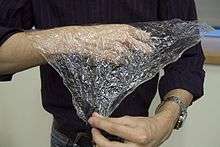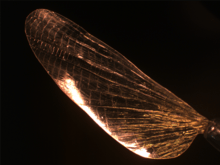Shrilk
Shrilk is a compostable material inspired by the insect cuticle and made from discarded shrimp shells and proteins derived from silk. Shrilk is thin, clear, flexible, and strong as aluminum at half the weight.[1] The structure of Shrilk is based in the design and components of the insect cuticle, being an alternative to non-degradable polymers and medical implants.[2] Shrilk is produced as films, which can be deposited on patterned molds to impart a specific patterning to the surface, and being able to tune or switch the elasticity allows simple engineering of 3D structures.[3]

Shrilk was developed in 2011 at the Wyss Institute for Biologically Inspired Engineering, at Harvard University by the Spanish materials scientist Javier G. Fernandez.[4]
Shrilk is an example of biologically inspired engineering.[5] It was the first biologically inspired material using a biological design at molecular scale with the biomolecules associated to it.[6]

Structure and properties
Shrilk is made by the sequential deposition of fibroin extracted from silk, and chitosan extracted form shrimp shells. The design mimics the layered structure of the insect endocuticle with similar components. The result is a composite with twice the strength of the stronger component (i.e.chitosan) and ten times the strength of both components blend.[7]
See also
References
- ↑ Mowatt, Twig (2012) Inspired by Insect Cuticle, Wyss Researchers Develop Low-Cost Material with Exceptional Strength and Toughness. Wyss Institute
- ↑ Chase, Jon (2012). As strong as an insect’s shell. Harvard Gazette
- ↑ Wylie, Lisa (2011). HShrilk: A Chimera of Chitosan and Fibroin for Biodegradable Plastics. Materials Views
- ↑ Ashley, Steven (2013). 9 Materials That Will Change the Future of Manufacturing. Scientific American
- ↑ Williams, Ann (2013). Super Materials. National Geographic
- ↑ Graber, Cynthia (2011). Insect Cuticle Inspires New Material. Scientific American
- ↑ Subbaraman, Nidhi (2011). Insect-inspired Material That Could Solve Our Plastic Problem. Fast Company
External links
- Unexpected Strength and Toughness in Chitosan-Fibroin Laminates Inspired by Insect Cuticle
- Advanced materials cover